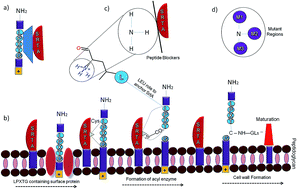Mechanistic insights of SrtA–LPXTG blockers targeting the transpeptidase mechanism in Streptococcus mutans†
Abstract
Streptococcus mutans has been chiefly involved as the major etiological agent of dental caries and adherence to the tooth surface for dental plaque formation, occurring through cysteine transpeptidase sortase A (SrtA) mediated covalent anchoring of surface proteins. SrtA recognizes the LPXTG sequence substrate located in the C-terminus of surface proteins and also acts as a decisive therapeutic target for the development of novel antimicrobial agents. Recent experimental studies have defined the role of fully conserved Leu and Pro residues of the LPXTG substrate in modulating the dynamics of the SrtA structure. Therefore, in the present work, we have examined the invariant Leu residue of the substrate with a view to understand its role in altering the dynamics of the enzyme substrate complex structure using molecular dynamic simulations and energy calculation methods. The results revealed that the Leu residue of the substrate appears to play the crucial role in anchoring and directing the conformational transition of the enzyme. In addition, we have identified the potential lead compounds which target the Leu residue of the substrate as peptide blockers to impede SrtA-mediated transpeptidation reaction. Hence, this approach provides a new platform for therapeutic drug targeting and the rational design of inhibitors against bacterial infections.


 Please wait while we load your content...
Please wait while we load your content...